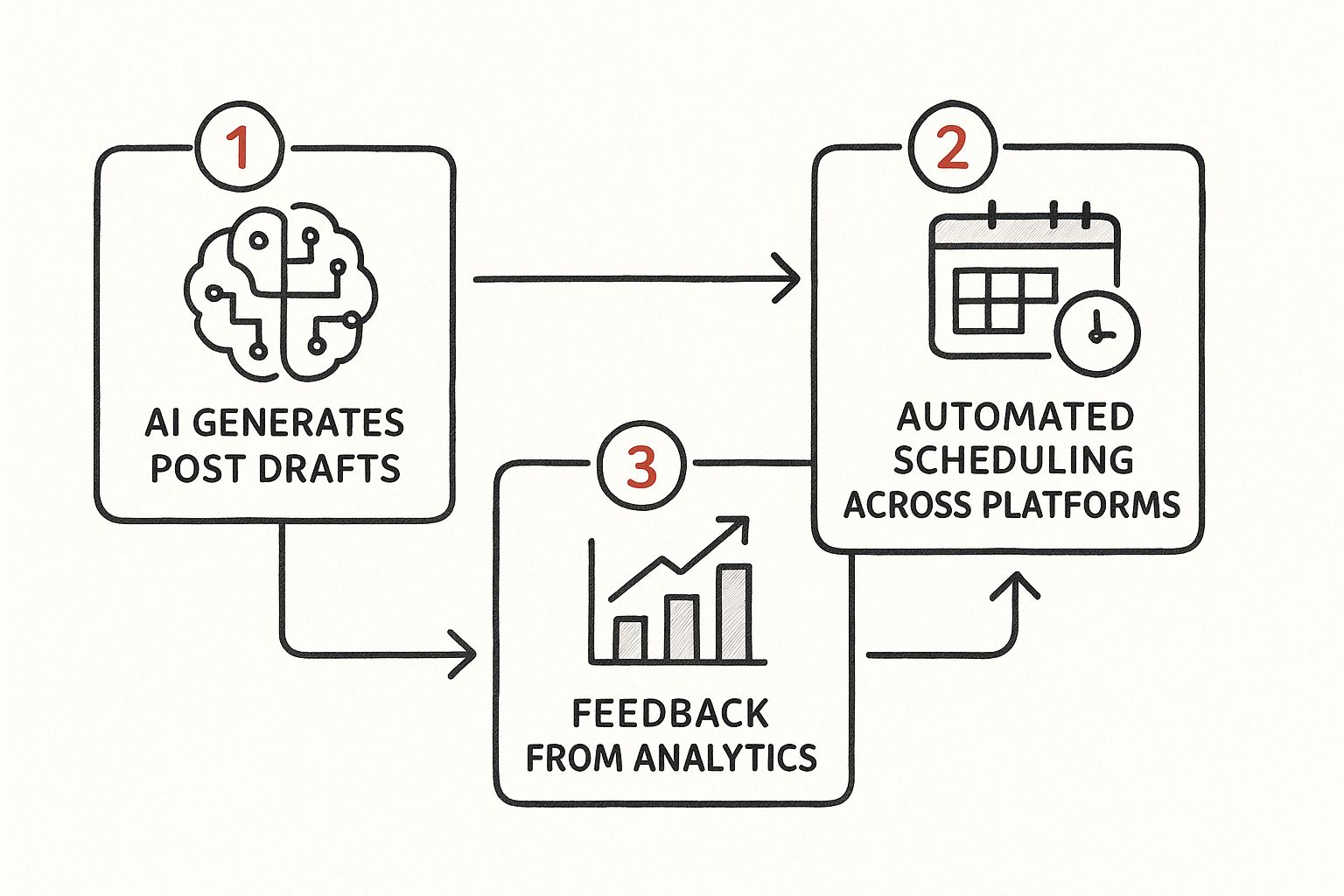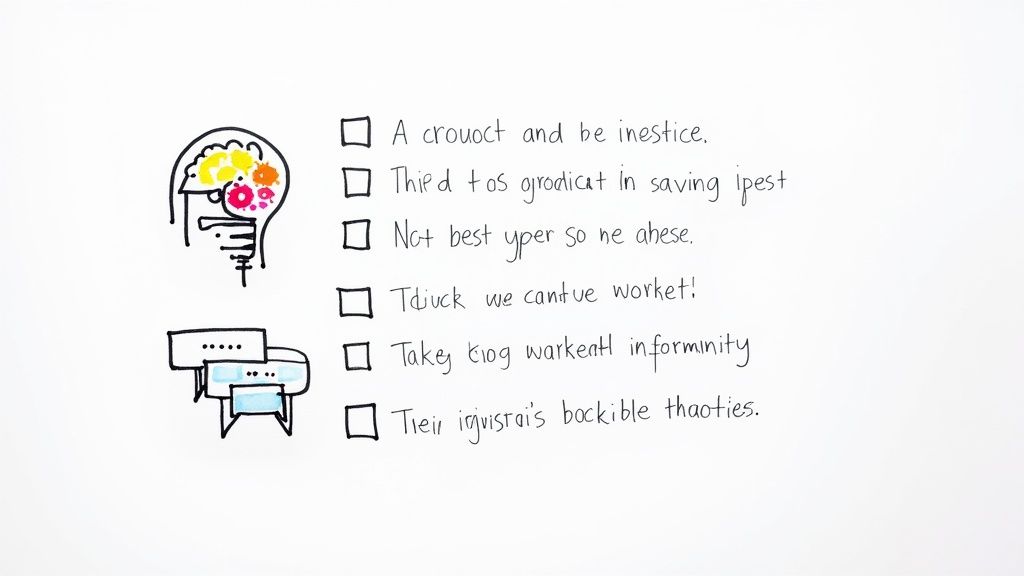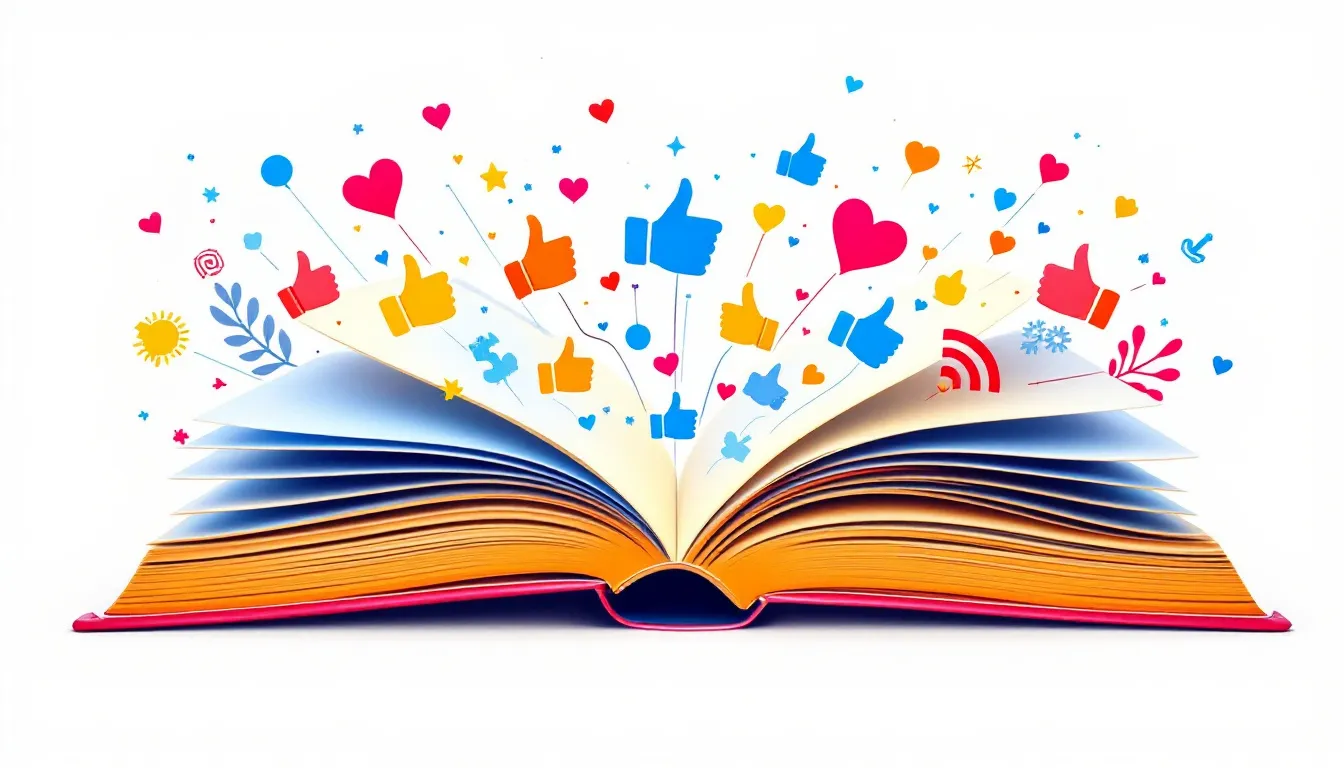AI Social Media Content for Authors: Boost Your Book Promotion

📱 Part of Our AI Marketing Series: This article covers social media content creation strategies. For the complete marketing workflow that shows how social media fits into your pre-launch, launch, and post-launch campaigns, see our comprehensive Complete Guide to AI Book Marketing.
Let's be real—using AI for your social media isn't about letting a robot take over. It’s about having a tireless creative assistant who can handle the grunt work of brainstorming and drafting. This frees you up to focus on what truly matters: connecting with your readers and, you know, writing your next book.
Finding Your Author Voice with AI

Before you even think about generating a single post, we need to talk about your author brand. This is the absolute most important step. Without a clear voice, any content you create—whether by you or an AI—will just feel hollow and generic.
The goal here isn't to have a machine invent a personality for you. Instead, think of it as a sparring partner. You feed it your ideas, and it reflects them back to you in new and unexpected ways, helping you clarify and amplify the voice that's already there.
Translating Your Book into a Brand
Your book is the heart of your brand. It’s the richest source material you have. A great starting point is to give an AI tool the core elements of your story. I'm talking about your book’s synopsis, a breakdown of your main characters, or the central themes you explore. This context is what the AI needs to start generating relevant ideas.
Let's say you write fantasy. You could describe your world's dark, magical atmosphere and your morally grey hero. From there, you could ask the AI to brainstorm taglines that capture that specific vibe.
- Prompt Idea: "My fantasy novel is set in a rain-soaked, gaslamp city ruled by corrupt mages. The protagonist is a cynical thief who unwillingly becomes a hero. Generate 10 potential social media taglines that capture this dark, hopeful tone."
From Vague Ideas to a Cohesive Presence
Once the AI spits back some ideas, your job is to sift through them. This is where your human intuition is non-negotiable. Which of those taglines or concepts actually feel like you? Pick the ones that resonate and discard the rest.
From there, you can start building out. Maybe you're a thriller writer whose brand is all about suspense and plot twists. You could ask an AI to help you develop a visual style. Try asking it for prompts you can feed into an image generator like Midjourney or DALL-E to create a mood board that nails your brand's aesthetic.
Key Insight: Your authentic voice is your greatest marketing asset. AI should serve that voice, not create a new one. The best results come from a partnership where you guide the AI with your unique vision and personality.
This whole process is more important than you might think. It mirrors how readers find content online today. AI algorithms already decide much of what people see in their feeds—in fact, about 71% of social media content recommendations are driven by AI.
By defining your brand this clearly, you're essentially giving those algorithms a roadmap to your ideal reader. As you can discover more about how AI is shaping social media on ArtSmart.ai, you'll see why establishing your unique author voice isn't just a creative exercise; it's a strategic necessity.
Never Run Out of Content Ideas Again
We’ve all been there. Staring at a blank social media calendar feels just as paralyzing as facing a blank page in your manuscript. The constant pressure to come up with fresh, engaging posts is intense. This is precisely where AI can become your secret weapon, transforming a tedious chore into a genuinely creative process.
The trick is to stop thinking of AI as a writer and start treating it like a super-powered brainstorming partner. You're still the creative director; the AI is your tireless intern, ready to spitball ideas 24/7. But remember, the quality of what you get back depends entirely on the quality of your instructions.
This image perfectly illustrates how that partnership works—it's a cycle of generating ideas, getting feedback, and then refining your approach.

What I love about this visual is that it emphasizes the feedback loop. You're not just creating content in a vacuum; you're using real-world performance to make your AI prompts—and your overall strategy—smarter over time.
Want a shortcut? ManuscriptReport's Social Media Ads/Content service creates 20 ready-to-post social media assets directly from your manuscript—complete with scroll-stopping images and captions written from 10 proven marketing angles. It will replace days of work from yourself or save you hundreds to thousands of dollars spent on social media agencies.
Crafting Prompts That Actually Work
If you give an AI a generic prompt, you’ll get a generic, soulless post. To get truly compelling ideas, you have to feed the machine specific, juicy details from your author world. Don't just ask for "social media posts for my book." That’s a recipe for boredom.
Subscribe & Get Your Free Marketing Plan Template
Receive regular updates on marketing best-practices, AI shortcuts, and get our proven 4-phase marketing roadmap for free.
Unsubscribe anytime.
Instead, get specific. Let's say you're a fantasy author. A much better prompt would be:
- "Generate five Instagram post ideas about the magical system in my novel, The Gilded Cage. The system is based on alchemy and requires sacrificing personal memories to cast spells. Focus on creating a sense of wonder and danger. Include a call-to-action asking readers which memory they would sacrifice."
See the difference? That level of detail gives the AI concrete material to build on, leading to far more unique and intriguing content hooks that will actually grab a reader's attention.
The goal is to provide enough structure for the AI to understand the tone, context, and desired outcome. The table below offers a few formulas you can adapt for your own books and platforms.
Effective AI Prompt Formulas for Author Content
| Content Goal | Prompt Formula | Example Platform |
|---|---|---|
| Spark Curiosity | "Generate 3 intriguing, one-sentence hooks for my book, [Book Title], a [Genre] story about [Brief Premise]. Avoid spoilers but hint at the central conflict." | Twitter, Instagram Stories |
| Share Behind-the-Scenes | "Create a list of 5 potential short video ideas showing the real-world research behind my novel, [Book Title]. Topics could include [Topic 1] or [Topic 2]." | TikTok, Instagram Reels |
| Promote a Sale | "Write a fun and urgent Facebook post announcing a limited-time 99-cent sale for my ebook, [Book Title]. Emphasize its [Key Selling Point, e.g., 'award-winning thriller']." | Facebook, Author Newsletter |
| Engage with Characters | "Write a short, funny tweet from the perspective of my character, [Character Name], who is a [Character Archetype], complaining about [Modern Annoyance]." | |
| Build Authority | "List 10 blog post titles for authors about my writing process. Focus on topics like [Your Specialty, e.g., 'crafting complex villains' or 'world-building']." | Blog, LinkedIn |
These formulas are just a starting point. Feel free to mix, match, and add your own creative flair to get the best results for your unique author brand.
Building Your Content Pillars with AI
A solid social media strategy is all about balance. You can't just shout "buy my book" all day. You need a healthy mix of content that entertains your audience, educates them, and, yes, promotes your work. AI is fantastic for ideating across all these categories.
- To Entertain: Ask for prompts that turn your characters into relatable memes or create fun "what if" scenarios. Think: "Write a funny tweet from my grumpy detective protagonist complaining about modern coffee shops."
- To Educate: Brainstorm topics that give readers a peek behind the curtain of your writing life. For example: "List 10 potential blog post titles about the historical research I did for my WWII novel."
- To Promote: Generate countdowns for a book launch or highlight a powerful quote from a recent review. Try: "Draft three short, punchy Facebook posts for my book launch next week, each revealing a different, non-spoilery detail about the plot."
A Pro Tip: Never settle for the first thing the AI gives you. Always ask it for multiple variations of an idea. This gives you a buffet of options to choose from and often helps you spot the most promising creative angles. I frequently find myself mixing and matching elements from three or four different suggestions to create one perfect post.
This isn't just a niche trick anymore; it's becoming standard practice. Recent data shows that 68% of content marketers now use AI tools specifically for brainstorming and ideation. You can see the full breakdown in Siege Media's study on AI's impact on content strategy.
By adopting these methods, you're not just saving time—you're building a sustainable engine for connecting with readers. If you're curious about which tools are leading the pack, we've put together a handy guide on the 12 best AI tools for authors.
Turning AI Drafts into Authentic Posts

An AI-generated draft is really just a starting line. The real work—and the real magic—begins when you step in to give that raw text a human touch. I like to think of AI output as a lump of clay; it's up to you to shape it into something that truly reflects your author brand and personality.
If you skip this step, the content ends up feeling hollow and disconnected. Writer Cat Johnson said it best: genuine communication is an exchange of energy. Your readers can feel you behind the words. The trick is to keep that connection alive by using AI as a creative partner, not a ghostwriter.
Injecting Your Authentic Voice
Your first pass should be all about voice. Seriously, read the AI draft out loud. Does it sound like you? If you were chatting with a reader, would these be the words you'd use? If the answer is no, it's time for a rewrite.
Start by swapping out bland, generic phrases with your own go-to words and expressions. If you write humor, inject your brand of wit. If you're a dark fantasy author, make the language more evocative and moody. This is your chance to drop in those personal stories, odd observations, and inside jokes that make your audience feel like they're in on a secret.
See the difference?
- Original AI Draft: "My new book explores themes of loss and redemption. I hope you find it compelling."
- Your Edited Version: "I poured so much of my own journey into this book. It’s about picking up the pieces after everything falls apart, and I can’t wait for you to meet the characters who helped me explore that."
That simple change transforms a sterile announcement into a genuine, personal invitation. And that's what builds connection.
Fact-Checking and Final Polish
As smart as these tools are, they aren't perfect. I’ve seen them invent "facts," get details about my own books wrong, or just say something that doesn’t quite fit my message. Always approach AI-generated text with a bit of healthy skepticism.
Before you even think about scheduling the post, run through a quick but critical checklist:
- Verify All Facts: Did the AI mention a historical event, a scientific concept, or another author's book? Take 30 seconds to double-check that it's accurate.
- Confirm Book Details: Make sure character names, plot points, and settings are correct. The last thing you want is for an AI to accidentally create a spoiler or misrepresent a character's journey.
- Sharpen the Call-to-Action (CTA): Is your CTA crystal clear? Instead of a vague "check it out," be direct. Try something like, "Tap the link in my bio to read the first chapter for free!"
A good rule of thumb I've developed is to aim to rewrite at least 30% of any AI draft. This practice pretty much guarantees the final post is original, accurate, and—most importantly—sounds like it came straight from you. Your personality is your most powerful marketing asset; don't let it get lost in automation.
Building a Sustainable Content Workflow
Let’s be honest: for a busy author, hearing that consistency is the key to social media can feel like being handed another full-time job. But what if I told you the secret isn't about frantically posting every single day? It’s about building a smart, efficient system.
This is where a solid workflow, powered by AI, can completely change the game. Picture this: you set aside one focused block of time each month to generate and schedule all your social media posts. It’s not a pipe dream. It’s a very real process that lets you blend the power of AI with smart scheduling.
The Magic of Batching Your Content
The strategy that makes this all possible is called batching. Instead of waking up and thinking, "What on earth do I post today?" you dedicate a few hours to create a whole month's worth of content in a single sitting.
This one shift frees up an incredible amount of mental space for the rest of the month. You can get back to what you actually love—writing your next book.
From my experience, the process looks something like this:
- Brainstorming: Fire up your AI tool and generate a list of post ideas for the month. Base them on your content pillars—things like behind-the-scenes writing life, book promotions, character deep dives, or reader Q&As.
- Drafting: Take the best of those ideas and ask the AI to flesh them out into initial post drafts.
- Polishing: This is where you come in. Go through every single draft and inject your personality. Add a personal story, tweak the wording to match your voice, and make sure it’s 100% you.
- Scheduling: Once polished, load everything into a scheduling tool. I've used tools like Buffer, Later, and Hootsuite—they all get the job done. Set the dates and times, and you're good to go.
This isn't some niche hack; it's quickly becoming the standard. A staggering 82% of businesses are now using AI writing tools. The reason is simple: AI-generated content can be produced an estimated 59% faster and at volumes 77% higher than doing it all by hand. It’s what makes this kind of consistency truly manageable for a creator. You can see more compelling statistics about AI writing adoption on Firewire Digital.
Your AI-Powered Content Calendar
Your content calendar is your roadmap, and it doesn't need to be fancy. A simple spreadsheet is often all you need.
I recommend creating columns for the post date, the social platform, the actual text, a link to the image or video, and a simple status column (e.g., "Drafted," "Edited," "Scheduled").
This is another area where your AI assistant can shine. After you’ve brainstormed your main themes, you can ask the AI to help you fill out the calendar. Try a prompt like: "Create a 4-week content calendar with daily post ideas for a fantasy author launching a new book. Include a mix of promotional, engagement, and behind-the-scenes posts."
Key Takeaway: Building a content workflow isn't just about being more efficient. It's about reclaiming your time and creative energy. When you batch and schedule, you guarantee your author platform stays active and engaging, even when you're deep in the writing cave.
For authors who want to really nail down this process, a detailed AI content creation workflow guide can offer some fantastic frameworks.
Thinking this way is a cornerstone of any modern author marketing plan. If you're looking to brush up on the fundamentals first, be sure to check out our complete guide on social media for authors. Ultimately, this system gives you the peace of mind that your marketing is running like clockwork in the background.
Using Analytics to Sharpen Your AI Strategy
Putting out a steady stream of content is a great start, but it's really only half the battle. The real magic—and the real growth—begins when you start paying attention to what your audience is telling you with their clicks, likes, and comments.
This means diving into your social media analytics. Don't think of it as a chore; see it as a goldmine of honest, direct feedback. This data reveals what truly captures your readers' attention, and you don't need to be a data wizard to figure it out. Just a few key numbers will tell you the story.
Decoding Your Core Metrics
Every platform has its own analytics dashboard, but the metrics that matter are pretty much the same everywhere. Instead of getting lost in a sea of charts, just zero in on the numbers that reflect what your audience actually cares about.
- Engagement Rate: This is your holy grail. It bundles up likes, comments, shares, and saves. A high engagement rate is the clearest sign that your content hit the mark and made someone feel something. That's the win.
- Reach and Impressions: Think of reach as the number of unique people who saw your post. Impressions are the total times it was viewed (one person might see it multiple times). When a post has high reach, you know it's cutting through the algorithm's clutter.
- Click-Through Rate (CTR): This is all about action. It tells you how many people clicked a link in your post, whether it’s to your book's Amazon page or your latest blog entry. It’s a direct measure of how persuasive your content is.
Keep your eye on these three, and you'll get a clear, practical picture of what's landing and what's falling flat. Once you've got this down, you can even explore more advanced ways to leverage AI for Instagram growth and engagement, pushing your best-performing content out to even more potential readers.
Creating a Powerful Feedback Loop
Okay, here’s where your AI-powered content strategy gets really clever. You're going to create a feedback loop by taking your performance data and feeding it right back into your AI tool. This closes the circle and turns numbers into better, smarter content.
Let's say you look at your last month's analytics and pinpoint your top five most-commented-on posts. Don't just give yourself a high-five and move on—put them to work.
Copy the text from those winning posts and paste them directly into your AI tool. Then, give it a simple but incredibly effective prompt.
A Game-Changing Prompt: "Analyze my five best-performing posts below. Identify the common patterns in tone, structure, and calls-to-action. Now, generate ten new post ideas based on these winning patterns, tailored for a thriller author."
Suddenly, you’re not guessing anymore. You’re not just tossing ideas at the wall to see what sticks. You are methodically figuring out what resonates with your readers and then building on that success.
You are, in effect, teaching your AI exactly what your unique audience wants to see from you. This continuous cycle of refinement is one of the most powerful AI-driven tactics to boost book marketing you can use, making every post you create more targeted and impactful than the last.
Your Top Questions About Using AI for Social Media

It’s completely understandable to feel a little hesitant about bringing AI into your creative world. I get it. As authors, our voice is our most valuable asset. So, let’s walk through some of the biggest questions and concerns I hear from fellow writers.
The idea isn't to let a robot take over your platform. It’s about having a tireless assistant to handle the tedious stuff, freeing you up to connect with readers and, you know, actually write.
Will My Posts Sound Like a Robot Wrote Them?
This is the number one fear, and for good reason. Your readers follow you for you.
The trick is to stop thinking of AI as a ghostwriter. Think of it as a brainstorming partner or a first-draft machine. The best AI social media content for authors always starts with AI but ends with a human touch.
Let the tool generate the initial ideas, the outlines, or a few different angles. Then, you step in. Your job is to weave in your personal stories, inject your unique humor, and polish the text until it sounds exactly like you. The AI gives you the clay, but you’re the one who sculpts it.
What Kind of Content Is AI Actually Good For?
I've found AI is an absolute game-changer for structured, repeatable content. This is where it saves you hours of work. Instead of asking it to write a deeply personal reflection, point its power at the things you have to create over and over again.
Here are a few things I regularly use it for:
- Generating Reader Questions: I'll feed it a chapter and ask for ten thought-provoking questions a book club might discuss.
- Finding "Behind-the-Scenes" Angles: I can prompt it with my research methods to get a list of shareable tidbits for my audience.
- Creating Ad Copy Variations: Need to promote a book sale? Ask the AI for five different tweets, each with a unique hook.
- Repurposing Blog Posts: Drop in a link to a blog post and ask it to slice it into a five-part Instagram carousel or a punchy Twitter thread.
How Can I Be Sure the Content Is Original?
Modern AI tools are designed to create new text, not just copy from somewhere else. But the surefire way to guarantee originality is to never, ever just copy and paste. Your personal editing process is the secret sauce.
My Personal Rule: I treat every piece of AI-generated text as a rough draft. I rewrite, rephrase, add my own anecdotes, and fact-check everything. This simple step not only ensures the content is 100% mine but also makes it far more engaging for my readers.
Is It Ethical for an Author to Use AI?
Absolutely, provided you’re being responsible and transparent. Using an AI tool to brainstorm marketing ideas or draft posts is just smart time management. It’s no different from using grammar software like ProWritingAid or a scheduling tool like Buffer. Think of it like hiring a virtual assistant to help manage your content calendar.
The ethical line gets crossed when there's an intent to deceive—like claiming a fully AI-written novel is your own work. But for marketing? As long as you are the final checkpoint ensuring everything is authentic, accurate, and high-quality, you’re simply using a powerful tool to work smarter.
Ready to turn your manuscript into a marketing machine without the hassle? ManuscriptReport.com extracts ready-to-use social media posts, blog series, and a complete marketing report from your book in minutes. Check out our affordable book marketing services or spend less time marketing and more time writing at https://manuscriptreport.com.
Enjoyed this article? Subscribe for more + get a free marketing roadmap template.
Receive regular updates on marketing best-practices, AI shortcuts, and get our proven 4-phase marketing roadmap template for free.
Unsubscribe anytime.
Related Articles

The Ultimate Affordable Book Launch Checklist: 9 Essential Steps for 2026
Complete affordable book launch checklist for 2026. Follow 9 proven steps—from budget planning to post-launch—for indie and self-published authors. Launch successfully for under $500.

How to Write Viral Book Hooks: 10 Proven Strategies for Social Media Success
Master the art of viral book hooks with 10 proven strategies, platform-specific tactics, and templates that grab attention on BookTok, Instagram, and beyond.

7 Must-Have AI Writing Tools for Authors
Discover essential AI writing tools for authors to boost creativity and streamline marketing. Learn actionable tips and explore solutions like ManuscriptReport.com.